If you’re reading this then there is a good chance that your pool pump is down, the anxiety is up and the algae monster is ready to pounce on your pool. After years in the pool industry, I can tell you many a homeowner has contacted us in a panic with a dead pump. The scenario usually goes as such: they or their tech has the pump apart and they are pondering the options that lay before them. They may know what they need but want to know if it’s worth the work to get the pump up and running. One of their major questions is, “Is it worth it to get a whole new pump or should I just get a motor?” The cost between a simple motor replacement and a pump installation can be sizeable. That difference in price makes it important for you and your wallet to know when to call it quits on an old pump.
Wreck-it or Recover it?
Our first step will be to determine the overall health of your pump. Over the years, this rugged piece of machinery has been subjected to blazing heat, driving rain and even lightning strikes. These conditions can drag down their overall health. The pump’s internal parts, as well as the housing and motor, can go bad and require replacement. When determining the magic number of replacement parts cost versus the cost of the whole pump, we generally suggest 60-75% as the standard. If the cost to repair is within or over this range, it is smarter to replace the pump. This way you have a brand new pump and warranty covering any mishaps down the line. There are a few other things to look out for when checking pump health. The key points are listed below.
- Dry Rotted or Cracked Housing – Besides a motor, the housing is the most expensive part of a pump to replace. If your housing is showing signs of deterioration, take a close look at the other parts of the pump. For example, the pump lid, basket, and impeller could be in need of repair as well. When totaling up the necessary replacement parts, keep in mind the magic number of 60-75%. If you get to that range, it could be time to replace the whole thing.
- Pumps older than 12-15 years – If it was a car you would have gotten rid of it by now. Sadly, unlike some vehicles, pumps do not appreciate in value as they get older. Pumps approaching this age see frequent breakdowns and repair. The cost of maintenance soon starts to outweigh the value of the old pump.
- Obsolete Parts – Some pumps for whatever reason are discontinued by their manufacturer. At that time, essential parts can be increasingly hard to find or unavailable. Review our pool parts section for your unit’s parts breakdown to determine their availability.
- Bronze or Cast Iron Pumps – Metal pumps were the standard for pools decades ago but they have been phased out. High strength composite materials have taken their place in the sun. The metal pump obsolescence has made parts hard to come by. If you are able to find the part, it will be at a premium.

Motors: Listen and Learn
If your pump’s wet end does not have any of the above red flags, a motor maybe your best option. First on the list when determining the status of your motor is to just be quiet and listen. The sound that follows a flick of the power switch can lend a big clue to what motor issues lie ahead. Motors, for the most part, are simple beasts. Once installed a motor needs little if any maintenance to keep it running. If a properly running motor starts to make any of the following noises, a replacement motor could be your next purchase.
- Loud Screech or Grinding – If your pump sounds less like an electrical motor and more like a Boeing Jet then your bearings are bad. Besides the age of the motor, these bearings can rust or freeze from the water inside the casing. The most common causes are a leaky shaft seal, flooding or even errant sprinkler spray. Bearings are the joints that spin the shaft freely or in this case cause you severe ear pain. The good thing is bearings can be replaced on the cheap. If you’re looking to go this route, then view our selection of pool motor bearings. If you do go this route keep in mind you will need a specialized tool called a bearing puller to remove the bearings.
- Humming Sound – Hmmm, what’s the cause? It’s the capacitor! This little barrel of fun stores an electrical charge to be dispersed to either kick start or keep your motor running. There are two types of capacitors, run (silver) and start (brown.) A blown capacitor is caused by a surge in power or overheating and is an easy fix for a handy homeowner. For the guide on replacing a capacitor, see our guide.
- Pop and a Click – Once your motor is tripping the breaker, it is on its last legs. When a motor is flipping the breaker, it is a sign of a deeper electrical issue.
- Silence – First check your power source. If that is fine then no, your pump is not resting. It’s dead. The silence is a sign that the inner workings of the motor have completely failed, i.e. the shaft has frozen. A motor that has reached this point is beyond repair.
Inspect your Gadgets
Legislators in pool heavy states like Arizona, California, Florida, and Texas have recently put strict regulations on replacement motors and pumps. The new regulations may require homeowners to upgrade their pump to dual or variable speed. The changeover to dual and variable speed pumps is meant to lessen the load on the electrical grid. The effect is also seen in the customer’s pocketbook. Dual speed and variable speed are designed to use less electricity thereby lowering your power bills. To help aid the transition, power companies are providing customer rebates when homeowners install new, qualifying motors. Check with your power company for the specific rebate details.
If you want more information on how these motors can save you money, read the following guides: How to Save Money Using a Variable Speed Motor or How to Replace a Single Speed Motor with a 2Green Motor
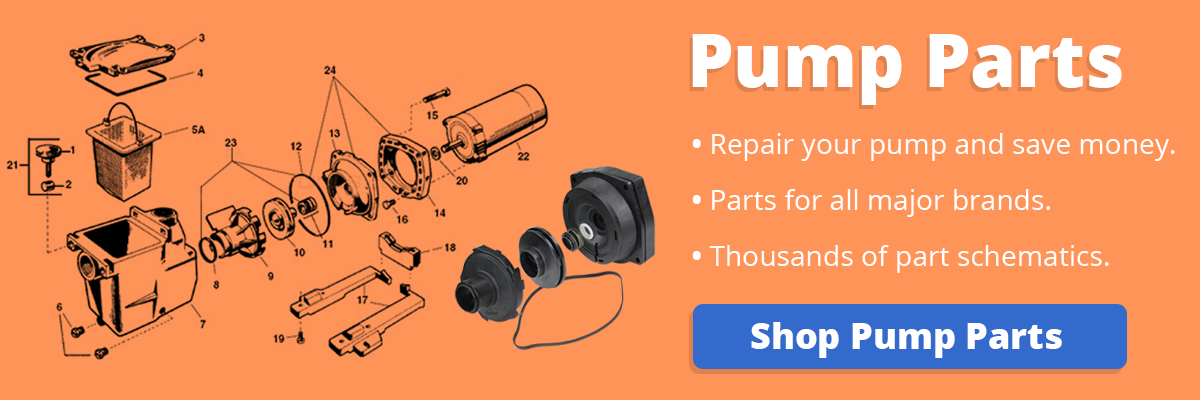
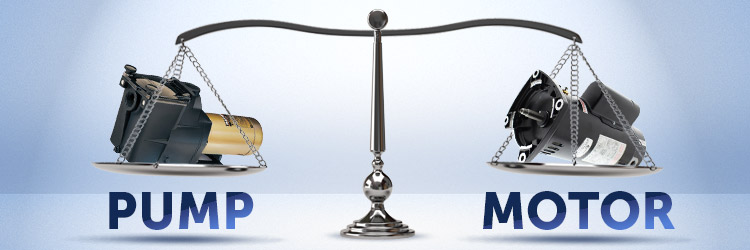
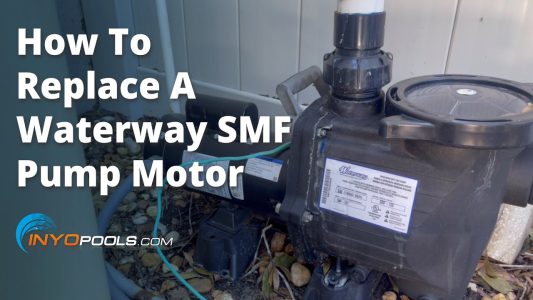
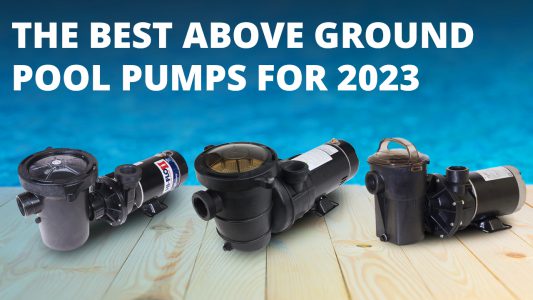
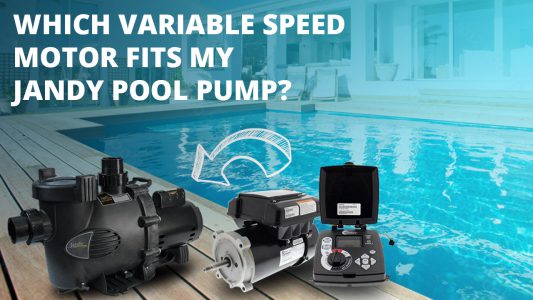
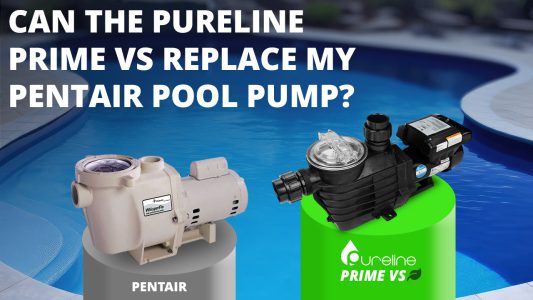






I am attempting to replace my spa motor (BN34) and wet end, but I’ve hit a snag. I can’t get the existing motor unbolted from the floor of the spa enclosure. The four bolts that secure the motor’s base down to the floor are completely rusted. I was able to break free the two bolts closest to the opening of the enclosure, but there is no room to work (or even see what is going on) behind the motor. Any tips on how to proceed with getting my old motor out?
Other than letting WD-40 soak on them, I wouldn’t have much a solution. I was going to suggest using an angle grinder before you said space was too tight for tools.
How many bearings do I need to get?
There are two bearings in pool pump motors.
Hi – I have a Hayward variable speed pump 3400 model. Wouldn’t you know on the best weekend of the summer I go out open the cover and noticed there’s not a lot of water movement. We keep it at a very low setting (a little over 30% of capacity) which keeps the salt chlorinator and the heater going. We’ve been gone quite a bit this summer but it worked last week. I always turn the motor up to about 90% for a few hours when I open it . Today when I look at it it had an error message saying pump failure and I turn the circuit breaker on and off in fact I left it off for a few hours and tried restarting. When it goes to the priming mode it makes a loud clicking noise as it primes usually within 40 seconds it shuts back off and the error message returns. Can I replace the motor or is it a complete pump replacement? Ours is only five years old.
One of those motors and drives would almost be the cost of a whole new SP3400VSP.
Looking on pages 29 – 30 on the EcoStar manual, I do not see “Pump Failure” code, they list a few others though. Take a look at the codes review the error message on your pump.
Hi I have a sta rite plm 100 and it looks like the pressure got too high as my pressure reader has blown out. Currently it’s silent out by the pool pump do you think I need to look at new motors or is there a chance it tripped a fuse only and? I don’t see any other damage or leaks anywhere… Of course my husband is out of town so I am trying to get what we may need before he gets back to fix this. Thanks in advance for the advice.
you can answer whether it has tripped a breaker, by looking at your breaker box. If it hasn’t tripped the breakers and still isn’t working then it is likely time to look at new motors.
But if you want to make extra sure, you can have an electrician or pool tech come out to inspect the circuit and motor.
I turn my pump on and it was making a loud vibrating sound. I thought my filter wasn’t installed properly since I just cleaned it. I have strong pressure 18 and everything is running great. Better than ever. Is this a sign the bearings are going bad? Would it hurt to run the pump?
Bad bearings make a loud screeching noise, rather than a vibrating sound.
Have you checked the pump stand and motor to see if maybe the vibration is coming from there?
I have a 5 1/2 year old house, pool and Sta-Rite PHK2RA6E-102L pump and it was working fine with no unusual noises. I went to turn it on yesterday and all it does is trip the breaker right away. I don’t get any noises or hums before it trips or hear anything. I flip the lever to manually turn it on and it trips right away. I am in South Florida and it has rained a lot the past couple days but nothing that hasn’t happen before. Could it be a bad breaker, wiring, timer or the pump/motor? Shouldn’t this pump last longer than 5 1/2 years? Thanks!
To test the breaker, move the pump to a different breaker to see if it trips or not. It could be the rain, that is somehow tripping the circuit. if you do not feel like waiting til the pump dries out, I suggest running new wires, or check the voltage of the lines on the pump side.
Unfortunately, new pump motors are lasting only 2-5 years nowadays. It is just the way they are built, they do not make them the way they used to. Give us an update.
I have a 1 year old Hayward variable speed pump (SP2300VSP, I think) that works great. However, winter seemed to sneak up on me & water froze in the pump housing. There is now a small crack in the threads of the outlet. I can still run the pump with just a very small leak. If I decide to replace the pump housing does it have to be the exact model or just something that fits the frame of the motor?
Thanks!
The same model pump housing needs to be used because the diffuser, impeller and seal plate will not fit on a different housing. Unless you plan on replacing all those parts, which is costly, I would just buy the right one.
Help….my husband is out of town and I have a dead pump. The pool repair guy is saying that we should replace the pump, but my husband is saying we only need to replace the motor. HELP!
I suggest giving our tech support line a call because we need more information to figure out what is the matter. We can be reached at 407-834-2200
I turned off my pump the other day and cleaned everything. The next day I went to turn it on, nothing. The breakers tripped. Little more inspection, it would buzz with nothing. Found out it need to be started by hand. No problem, got it going, haven’t had any problems. Now we can get it going but the suction is not strong enough to pull enough water. Does the starter/compacitator have anything to do with this, or does it sound that more than likely the the pump is dying?
Usually, when there is a bad hum and it needs a hand start, the capacitor is failing. Luckily, replacing a pool pump capacitor is relatively easy and inexpensive. Did you need any help finding a replacement capacitor?
I have a question about bearings…. my pump would not start at first.. It would only hum. Turns out the rotor assembly was stuck and would not turn. I used a screw driver to turn it manually and then it would start. Now however, it shrieks when it runs. It’s two years old. The bearings look good and turn easily – and silently – by hand. Could this shrieking be bad bearings even though they turn quietly by hand, or could it be the caused by a rusty rotor wearing on the motor coil in the housing?
So you opened the motor to view the bearings, but didn’t bother just to change them out of precaution? That would save you from having to crack it back open to replace them later.Also if you opened the motor to see the bearing, you probably could have found any rust that was lingering in the motor.
My pump turned off . I went to reset an the breaker trips. Every time I reset the breaker a loud noise (like an electric shock) in the motor and trips the breaker.i inspected the motor and it’s not stuck it rotates fine ,
Have you tried putting the motor on a different breaker? This will determine if the motor or the breaker is at fault.
What HP would you recommend for an inground 60,000 litre / 16,000 gallon pool. Please keep in mind that the pump location is about 3ft above the pool deck. Thanks.
To figure out the correct pool pump size, you will need more information to calculate flowrate and run time. Follow the steps we mention in the pump selection guide for the best results.
how much is a housing unit for my pool pump
What model is your pool pump?
My motor sounds like it always has, but just 50 times LOUDER. Would that be the bearings? Also, if my motor needs replacing, how do I know which motor is compatible? My particular motor (Marathon 1HP) is discontinued. Are they pretty universal once you get the voltage, HP, Frame type down?
If the motor is super loud, then it is likely the bearings. If you are brave, you can try replacing the bearings, but I always prefer to replace the whole motor.
Though Marathon is no longer around we can still get you the right motor. To find the right motor replacement we just need the Part, Catalog (CAT), or Model (MOD) number to identify it. We have a blog on how to read a motor label too.
If your label is too sunbaked to read, find the Pump’s model number on the pump housing. The model number is also important in finding the correct shaft seal to complete the motor replacement. If you don’t replace the shaft seal along with a new motor, you’ll be hearing that bad bearing sound, very soon.
These are some great things to consider about your pool pump. We’ve been trying to decide if we should repair or replace ours. The cost range to repair you gave is perfect.
Since deciding to build a pool my husband and I have fretted about learning all the tricks to maintenance. I’m still learning all about pumps and motors and am worried that I’ll miss something and end up paying for a repair that I could have avoided. Do you have a checklist or any tips to make sure that you do the right things to avoid needing repairs?
Hello Olga, eventually any pool equipment will need repair so we can not prevent that. But we do have a 128-page Ultimate Pool Care guide we email you once you sign up for our newsletter. Visit http://www.InyoPools.com and enter your email in the newsletter pop-up. The Ultimate Pool Care guide should cover any and everything you need or you can review our How-to guide section if you need further help.
My husband and I are getting a pool installed in our yard. We are really excited and we want to know how we can best care for our pool. One of the most common things we have herd people stress about is their pool pumps. It is good to know that after about 12 years a pump should probably be replaced. We will have to keep that in mind!
My grandma has an old well that hasn’t worked in a while, so we decided to take a look at the pump. It is pretty beat up, so my grandma will either have to get it repaired or replaced. The housing still looks okay, and it isn’t making any strange sounds, so maybe it can still be fixed!
Fingers crossed! Let us know how it turns out.
I think that inspecting the housing is a good idea. My friend recently replaced his electric pump. I helped him mount it into the floor. Also, we put in a new power supply for it. What kind of pumps are your favorites?
My favorite pumps are the simple and familiar ones like the Hayward Super Pump or the Pentair Whisperflo. I prefer these pumps for two reasons: they have been used on pools for decades, their design is tried and true and unlikely to show any design quirks like the Hayward Northstar(do not even get me started on that pump.) And secondly, these two pumps are super popular, so finding parts online or locally is easy for a pool owner needing a quick fix.
But my favorite pump overall is the Pentair IntelliFlo VF because of its durability and ability to keep a constant flow. The VF model is unique to the other IntelliFlos and Variable Speed pump models because the user inputs the GPM they desire rather than RPMs. The pump self-adjusts its RPMs to reach the flow instead of using RPMs that takes a “dial it in” approach with any new installation. As a pool’s filter becomes dirty the flow of water begins to slow decreasing a normal pump’s GPM but the VF will sense the slowing flow rate and raise its RPM level to maintain your desired RPMs.
Mathew I read an older response (Sep 32 2015) from you that your favorite pump and motor is the Pentair Intelliflow VF. I currently have Pentair WhisperFlo that is more than 20 years old and a replacement 2 HP motor that is about 5 years Old. I had a water leak on the dry side and the motor is showing water damage. I rebuilt the motor following a seal failure and noticed that at least one motor mounting screws hole on the bottom of the pump broke off. They are working now but I know I will need to replace both sooner rather than later. The Intelliflow VF is a bit too much money and may be overkill for me. Should I replace the pump and motor with the WhisperFlow or bite the bullet on the more expensive Intelliflo VF recommended?
If the VF is too pricey, I would stick with the WhisperFlo, but maybe consider a dual-speed instead of a single. Going dual speed is a little more money than the single, but it will save you money in the long run. Also, just because I prefer the VF, that doesn’t mean the VS (011018) should be overlooked. It is the same housing and motor combo just with a less fancy control/timer. Just for future reference, Pentair are removing some products from online retailers, making them brick and mortar store exclusives; our site may show them as NLA, but they are still available.
If you want to steer away from Pentair, we are growing fond of the Waterway Defender VS, it has similar flow rates to the WhisperFlo.
Thanks for sharing this advice on when to repair or replace pumps and motors. I had no idea that a pump older than 12 years old would be considered something that needs to be replaced! If that’s the case, then my pool really needs to get a new one soon. If I’m remembering correctly, the pump in there should be about 20 years old!
Thanks for the tips. I think my pump is pushing around 15 years and really needs to be replaced. I have noticed a few problems that it has started to have as the years have gone on. I really hope we can get them fixed before there are any real problems.
I know very little to nothing about this kind of thing. I’m sure that it’s not that complicated if you are a professional and do it all the time. Maybe I should get one of those professionals to come and take a look at my pump. I wouldn’t know how to fix it if it was broken.
Thanks for the information on what different sounds made when my motor is turned on mean for my motor’s health. Mine typically makes a humming sound when I turn it on. I’ll be sure to replace the capacitor, like you suggested.
Great, let us know how it works out for you.
I would really like to look into getting a new pump for my pool, or at least get the one repaired that I have right now. After reading more about repairing pumps, it sounds like my pump may be past the point of saving. It is incredibly old, probably about twelve years old by now, so it is probably just getting really worn out. I think it would be good to look at new pumps to try to find one that is more efficient and that will last a long time as well!
Skylar, thank for the post. if you are looking for a pump replacement then there is no better place than Inyo’s Pump Section. If you have questions about anything you see, do not hestiate to email or call our techs at 877-372-6038
My hot tub woke me up in the middle of the night sounding like static from the tv. And no water movement. Would that be the motor or just the wet end needing replaced.
Terry – unfortunately, I cannot tell you what it is just by the description of the sound. When it comes to troubleshooting a pool/spa pump, you need to open it up to check for damaged parts or get hands-on to check the motor.
Both of my pool pumps are over 12 years old.
AO Smith motors with Pentair whisperflow pumps.
Recently and at different times, they both began to leak water. I pulled both motors inspected and cleaned everything. I then replaced the seal plate gasket, diffuser o-ring and shaft seal. Pretty much every seal.
I Cleaned up the bolts and carefully re-installed everything.
Total cost of new parts for both pumps $34.
All in all, it took me about 2 hours labor primarily because one of my pumps is precariously located under pipes, etc.
No leaks and I’m sure they’ll give me several more years of service.
Awesome! Great work.
Most of the time I would much rather recover it, rather than wreck, but I do understand that recovering it is a cheaper process. As far as my engine goes, I think it still has enough life in it to warrant a recover rather than a wreck. I would say that there are at least a few of the example problems you listed here, especially the grinding noise. It is quite unpleasant, and I want to fix this as soon as possible.